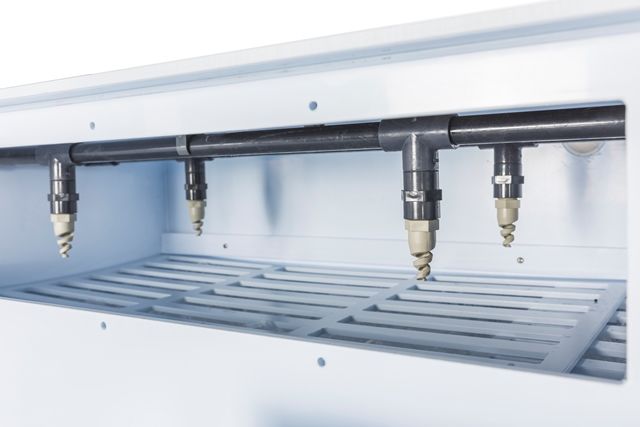
Topic:
Key Considerations
Wet-scrubber fume cupboards have a scrubbing system comprising of a bed of plastic (normally polypropylene) 3D shapes (pall rings) over which nozzles spray a fine mist (media). The pall rings give maximum surface area for fumes to adhere to as the exhaust air passes through them. A mist eliminator collects vapour from the airstream before it enters the exhaust duct.
The scrubbing media drains and is recirculated back to a tank. Good systems have an auto top-up and drainage system to eliminate any manual monitoring and (in the case of using water) to keep the scrubbing media constantly refreshed. It also then drains highly diluted chemicals into normal lab drainage.
In many situations, mains water is sufficient as a media but other solutions can be used if required.
Water wash-down (or water-wash) fume cupboards have spray nozzles above/behind the cupboard baffles to partially scrub the vapours and send a continuous sheet of water down the interior walls, baffles and upper duct connections. It should be combined with a duct wash down system. The water is collected and drained to waste. They also have a mist eliminator – more on that later. The system can be run after each use but we recommend running the duct wash-down at all times as otherwise there is the possibility that vapour can enter the duct.
This type must NOT be confused with standard cupboards that have a workspace wash-down system. They have nozzles mounted on the ceiling of the cupboard workspace to allow workspace cleaning only (with the sash closed of course!). That system is often misunderstood or mis-sold as suitable for Perchloric use but is effectively only for cleaning purposes.
It is down to application. Wet-scrubber fume cupboards are used to remove or neutralise the harmful substances emitted from chemicals or particles from the airstream prior to venting to the environment. This can be down to Corporate Responsibility and Environmental Policies, proximity of duct stacks to neighbouring properties, or even due simply to the odour created by some processes!
Water wash-down cupboards are created specifically for use with Perchloric acids. Perchloric acid vapours are not only highly corrosive but the real issues occur when the vapours condense inside the cupboard or more importantly the ductwork.
When the condensed vapour evaporates it leaves behind a salt called perchlorate. Perchlorate crystals are extremely unstable and can detonate through heat, flame, friction, percussion or chemical reaction. Just the minimal vibration of an extract fan can cause a violent reaction.
Fortunately the chlorate salts dissolve easily in water.
The jets of water behind the baffles and streams of water inside the cupboard prevent any crystals forming inside the cupboard and the mist eliminator prevents vapours from entering the duct.
As a fail-safe we recommend fitting a duct wash-down system (further water jets) inside the first 2-3 metres of horizontal duct. Slope the duct back down towards the cupboard so that the water can drain back into the cupboard. It also effectively rinses the mist eliminator.
So to summarise, Wet-Scrubber cupboards clean the exhaust air whereas the Water wash-down cupboards rinse all surfaces that exhaust vapours come into contact with. For either type you must choose a metal-free product as these units are typically used with acids which eat through 'chemical resistant' coatings and get behind 'chemical resistant' linings.
For more information on these types of fume cupboards, please get in touch with our team.
Read our Privacy Policy for more information on how we collect and process data.



No thank you
Read our Privacy Policy for more information on how we collect and process data.